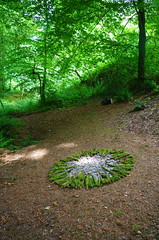Cley next the Sea is a village which hundreds of years ago was a bustling port by the North Sea along Britain’s North Norfolk coast. Over history, there has been a process of silting up, causing this medieval port to be moved steadily northwards – until today the village of Cley is divided from the coast by a flat expanse of salt marsh, and the port has now completely disappeared.
UK environmental artists Liz Mc Gowan and Jane Frost are embarking on an extended conversation about the shifting tidelines of this part of the world. It’s part of their exhibition for a bigger annual exhibition due to take place in a couple of months’ time: Cley 14.

photo: Liz McGowan. Old lighthouse on North Norfolk coast
As an artist with similar environmental interests, living and working on the North Devon coast, a completely different part of the country, I was delighted to be invited to contribute to Jane and Liz’s conversation. I could not resist comparing the different characteristics of our landscapes, the weather, the impact of the sea, and the responses of human beings. A prolonged spell of stormy weather a couple of months ago has caused havoc and a lot of flooding in many parts of the UK, not just in Norfolk and Devon, and it has brought the reality of changing weather patterns well and truly home to many of us. I was quite ready to look around at the shifting interface between land and sea, and its implications.
Somehow, in addition to actually listening and talking with others about one’s individual experiences – one’s feeling for the land, one’s connection – somehow this is not at all the same as merely hearing about environmental concerns on the news or elsewhere. The same goes for carrying out creative actions as artists in the landscape. It becomes real: a sort of physical and psychological intimacy, part of oneself.
So I have edited down as short as possible a recent Skype conversation I had with Liz, where we talked about Cley, and Liz and Jane’s project, whilst gradually familiarising ourselves with each other’s places (which we knew nothing about beforehand).
First, here is a brief description of each place:
Liz and Jane’s Place: Cley and surrounding area
Flat, shifting moving terrain, characterised by sand, shingle beach, reedbeds and extensive areas of saltmarsh, lying within the North Norfolk AONB. Norfolk Wildlife Trust manage an exemplary nature reserve on Cley Marshes, an important stopping point for migrating birds.
As I mentioned earlier, in medieval times Cley was a thriving port, but with the process of silting up, the sea is about a mile away, and can now only be reached by crossing the marshes to the shingle beach.
Cley was protected by a shingle ridge, to a large extent swept away in a devastating storm in 1953 in which people lost their lives. There have been further surges in more recent times, and homes and land continue to be lost through the relentless incursions of the sea.
My Place: Northam Burrows and surrounding area
On the Torridge estuary facing the Atlantic. Built up into its peninsula shape by sediment carried down river and deposited. Small area of saltmarsh and mudflats… Sand dunes and grassland, flanked along one side by the long Pebble Ridge consisting of large seaworn pebbles carried by longshore drift from further along the coast. A wide range of habitat for coastal plants, migrating birds and wildlife, make the Burrows environmentally valuable. It is a designated SSSI, as well as a part of the North Devon AONB and a UNESCO Biosphere Reserve.
In contrast to the flat land of North Norfolk, the surrounding terrain of the Burrows is sandstone and mudstone rock, with steep wooded cliffs, and a backdrop of gentle green Devon hills. The natural ecology of the area is being put under continual pressure by human activity, and relentless housing and other developments. Flooding and damage to property and infrastructure were experienced recently, caused by a prolonged spell of unusually severe rainstorms.
Here’s the link to our talk – it is a little long (16 mins) but interesting in terms of learning about our changing coastlines… and also how artists can arrive at a bond of understanding, through feeling their way tentatively forward into the unknown.

Me on the saltmarsh of Northam Burrows, gazing across the estuary to Appledore.
If you type Northam Burrows in my search box it should bring up a number of earlier posts I wrote about this particular area, all complete with pictures.
Liz and Jane’s project, is as yet in its early stages, but to find out more, and to see some of the artists’ coastline pictures (particularly of the devastation caused by the sea in North Norfolk) please visit the Facebook Album:
Happisburgh and other Shifting Coastlines
Also, see the conversation on the blog site
http://betweenthetidelines.wordpress.com/





Pingback: The Cabin: Shadows and Little Views | THROUGHSTONES
Pingback: March to May – Conversations and Preparations | Between the Tidelines
Looking forward to how this will eventually present itself. It’s wonderful to have other artists that you can discuss projects with that have some sense for what you do.
LikeLike
Yes, it certainly is! And strangely enough, I saw a TV film over Easter, where archaeologists were exploring the remains of what turned out to be a Bronze Age city under the ocean. It made me realise that what Liz and I were talking about were just the natural processes of life on Earth that have been going on for thousands of years.
LikeLike